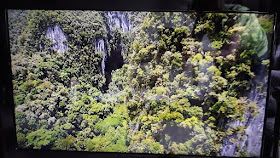An article appeared in arsTechnica in Sept 2020 "Mathematicians may have unlocked the secret of how “stone forests” form".
The article mentions stone forests such as those in China's Yunnan province and the tsingy in Madagascar. There is no mention of Mulu's pinnacles. The article says "These pointed rock formations, like the famed Stone Forest in China's Yunnan Province, are the result of solids dissolving into liquids in the presence of gravity, which produces natural convective flows". And "Soluble rocks like limestone, dolomite, and gypsum are submerged under water, where the minerals slowly dissolve into the surrounding water. The heavier water then sinks under the downward pull of gravity, and the flows gradually form karst topographies. When the water recedes, the pillars and stone forests emerge."
This is a controversial subject. The mathematicians based their findings on dissolving candy in a water tank. However in the case of limestone formations, these are generally thought to be subaerial erosion features. There are a few discussions about this in the comments. Also reference to an article in an international caving journal , "Origination of stone forests in China", which I think is more credible!





















